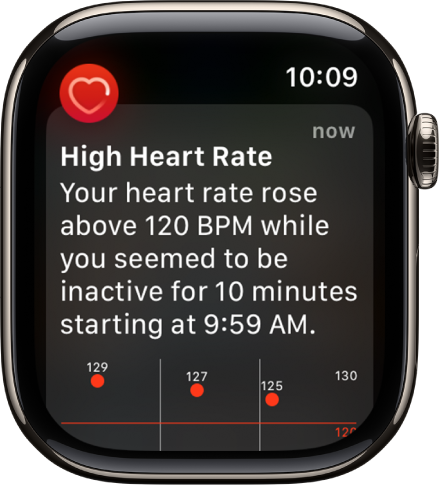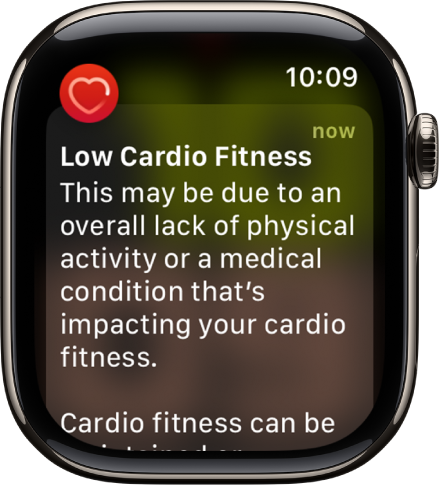Heart Health
Your Apple Watch can tune in to your heart and send notifications when something out of the ordinary occurs. For example, your Apple Watch can notify you if your heart rate remains above a chosen threshold or below a chosen threshold after you’ve been inactive for at least 10 minutes.
You can turn on heart rate notifications when you first open the Heart Rate app, or at any time later.
You can also receive a notification if your Apple Watch has identified an irregular heart rhythm that appears to be atrial fibrillation (AFib). If you have already been diagnosed with AFib, your Apple Watch can help you understand how frequently your heart is in this arrhythmia. You can also track lifestyle factors that may influence your condition.
Receive high or low heart rate notifications

Go to the Settings app
 on your Apple Watch, then tap Heart.
on your Apple Watch, then tap Heart.Tap High Heart Rate Notifications or Low Rate Notifications, then set a heart rate threshold.
You can also open the Apple Watch app on your iPhone, tap My Watch, then tap Heart. Tap High Heart Rate or Low Heart Rate, then set a threshold.
Set up irregular heart rhythm notifications (not available in all countries or regions)
You can receive a notification if Apple Watch has identified an irregular heart rhythm that appears to be atrial fibrillation (AFib).
Go to the Apple Watch app on your iPhone.
Tap My Watch, tap Heart, then tap Set Up Irregular Rhythm Notifications in Health.
In the Health app, tap Set Up, then follow the onscreen instructions.
Show AFib history (not available in all countries or regions)
If you’ve been diagnosed with AFib, go to the Health app on your iPhone, then tap Browse.
Tap Heart, scroll down to Get More From Your Health, tap Set Up under AFib History, then follow the onscreen instructions.
To show your AFib history, open the Health app, tap Browse, tap Heart, then tap AFib History.
Every Monday, if you’ve worn your watch for at least 5 of 7 days (12 hours a day), you may receive a notification with an estimate of the time you spent in AFib during the previous calendar week.
For more information, see the Apple Support article Track your AFib History with Apple Watch and Atrial Fibrillation History Feature (AFib) Instructions for Use (IFU).
Set up low cardio fitness notifications
Apple Watch can provide you with cardio fitness estimates by measuring how hard your heart is working during an outdoor walk, run, or hike, and sending you a notification when it’s low. Depending on your age and sex, your cardio fitness will fall into one of four ranges: Low, Below Average, Above Average, or High. If your cardio fitness level falls in the Low range, you’ll receive a notification on your Apple Watch. If it stays low, you’ll receive a notification every 4 months.

Go to the Apple Watch app on your iPhone.
Tap My Watch, tap Heart, then tap Set Up Cardio Fitness Notifications in Health.
You can also open the Apple Watch app on your iPhone, tap My Watch, tap Heart, then turn on Cardio Fitness Notifications.
Look in the Cardio Fitness section of the Health app to see your cardio fitness measurements and the range they fall into. Tap Show All Cardio Fitness Levels for more information.
